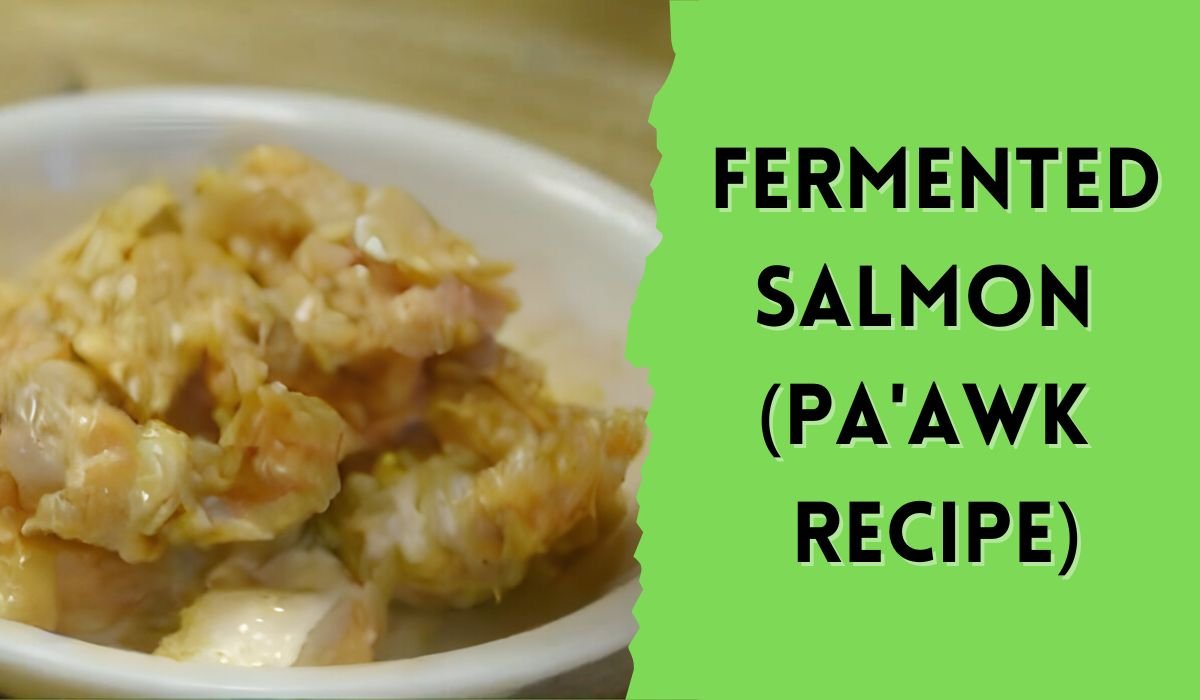Fermented Salmon Recipe (Pa’awk)
Traditional Fermented Salmon (Pa'awk): A Flavorful Journey with Lemongrass and Chili

Today, I’m going to share a recipe for Fermented Salmon, from Southeast Asia also known as Pa’awk. It’s a traditional dish with a rich history and a unique tangy flavor that will make your taste buds dance.
Whether you’re a seasoned chef or just starting out in the kitchen, this simple and tasty recipe is perfect for anyone looking to impress their family and friends.

Fermented Salmon Recipe (Pa’awk)
Equipment
- 1 Large mixing bowl
- 1 Blender or spice grinder
- 1 Roasting pan
- 1 Steamer
- 1 Clean glass jar with a lid 2-3 liters (or 2-3 quarts)
Ingredients
- 6 lbs. salmon (leftover pieces or fillets)
- 4 tbsp. salt (preferably sea salt)
- 8 tbsp. roasted jasmine rice powder (about ½ cup of uncooked jasmine rice)
- 1 tsp. MSG (Monosodium Glutamate) (optional)
- 1 tsp. sugar (optional)
- 3 cloves garlic, chopped
- 3 stalks green onion, chopped
- 1 stalk lemongrass, finely chopped (optional)
- 1 tsp. chili flakes or fresh chopped chili (optional)
Instructions
Prepare the Salmon:
- Cut the salmon into smaller pieces if necessary.
- In a large mixing bowl, add 4 tablespoons of salt to the salmon.
- Using your hands, squeeze the salt into the fish thoroughly, making sure the juices are pressed out.
Roast the Jasmine Rice:
- In a pan, roast jasmine rice on medium heat until it turns golden brown.
- Allow it to cool, then grind it into a powder using a blender or spice grinder
Mix Ingredients:
- Add 7-8 tablespoons of roasted jasmine rice powder to the salted salmon.
- Optionally, mix in finely chopped lemongrass and chili flakes (or fresh chopped chili) to the salmon for extra flavor.
- Combine everything until the rice powder and spices are evenly distributed.
Jar the Mixture:
- Pack the salmon mixture tightly into a clean glass jar. Ensure there is minimal air inside.
- Seal the jar with a lid and store it in a cool, dry place for fermentation.
- The fermentation process can take 25-30 days depending on the temperature (longer in colder conditions).
Prepare for Steaming:
- After the fermentation period, the salmon is ready to be cooked. Add 1 teaspoon of MSG (optional) and 1-2 teaspoons of sugar if you prefer a sweeter taste.
- Mix in the chopped garlic and green onions.
Steam the Salmon:
- In a preheated steamer, steam the fermented salmon for about 10 minutes or until it's fully cooked.
Serve:
- Serve the fermented salmon with steamed rice, fresh vegetables (cucumber, eggplant), and chili for a balanced and flavorful meal.
Notes
- The addition of lemongrass and chili adds a refreshing citrusy note and a spicy kick to the dish.
- Fermentation time can vary based on climate. Warmer climates speed up fermentation, while colder ones slow it down.
- Adjust the amount of sugar or MSG to your taste preference. You can buy plant based MSG online here.
- MSG stands for Monosodium Glutamate, a flavor enhancer commonly used in cooking. It’s a sodium salt of glutamic acid, a naturally occurring amino acid.
- The dish can be stored in the refrigerator after fermentation for several weeks.
- Pa’awk is often enjoyed with sticky rice and fresh vegetables in traditional Southeast Asian meals.
- If you don’t have a spice grinder, I suggest getting this one. It’s the best value for money spice grinder I could find.
- Finally, if you’re looking for jar’s suitable for fermentations You can purchase these 4-pack 32-Oz mason jars with Airlock lids from amazon
How To Serve Your Fermented Salmon?
Fermented salmon can be enjoyed in many tasty and fun ways. Here are some popular methods to enjoy this nutritious dish:
- Bagels: Pair fermented salmon with rye bread or bagels and cream cheese. You can also add capers or pickled onions for extra flavor.
- Baked Salmon with Sauerkraut: Marinate the salmon in olive oil and lemon juice, then bake it topped with sauerkraut until it turns golden. Serve with rice or steamed vegetables for a hearty meal.
- Salmon Carpaccio: Thinly slice smoked or cured salmon and arrange it on a plate. Drizzle with olive oil and lemon juice, and top with crispy lemon rinds for a refreshing appetizer.
- Salads: Add fermented salmon to salads. It goes well with mixed greens, cucumbers, and a light vinaigrette. You can also add avocado or nuts to enhance the dish’s texture and flavor.
- Canapés: Serve thin slices of fermented salmon on crackers or small pieces of bread topped with cream cheese, herbs, or pickled vegetables for elegant appetizers.
- Tacos: Use fermented salmon as a filling for tacos. Combine it with fresh vegetables, avocado, and a tangy sauce for a modern twist.

Can you use vinegar in the fermentation process?
Yes, you can use vinegar in the fermentation process, but I don’t think it would be called “fermented” anymore; rather, it would be called “pickling”.
Vinegar is mostly used in pickling, which is a form of preservation that relies on the acidity of vinegar to prevent harmful bacteria from growing.
However, in traditional fermentation, where beneficial bacteria (like lactic acid bacteria) break down sugars to preserve food, adding vinegar isn’t recommended, as it can mess with the natural fermentation process.
Pickled fish in vinegar is common in some cuisines, but it’s not the same as traditional fermented fish.
Why fermented salmon is sometimes called “gravlax”?
Fermented salmon is called gravlax because of its historical preparation method and origin. The word “gravlax” comes from Scandinavian roots:
- “Grav” means “grave” or “to bury” in Swedish, Danish, and Norwegian.
- “Lax” means “salmon.”
Traditionally, fishermen in Scandinavia would cure salmon by burying it in the sand or ground, along with salt, sugar, and sometimes herbs, to ferment it slightly. This process would preserve the fish, allowing them to store it for longer periods. [1]

Today, gravlax refers to salmon that is cured with salt, sugar, and dill, but the modern method doesn’t involve actual fermentation or burying.
While both gravlax and other types of fermented salmon involve curing fish, gravlax is lightly cured, while fermented salmon (like the one in our recipe) can involve a longer fermentation process for more intense flavors.
Gravlax vs. Pa’awk: Recipe Differences
The key differences between the Scandinavian fermented salmon (gravlax) and the Southeast Asian fermented salmon (Pa’awk) lie in the ingredients, preparation methods, and fermentation process.
Here’s a table with the main differences:
| Gravlax | Pa’awk | |
|---|---|---|
| Main Ingredients | Salt, sugar, dill | Salt, roasted jasmine rice powder, optional: lemongrass, chili, garlic |
| Additional Ingredients | Sometimes juniper berries, black pepper | MSG, sugar (before steaming) |
| Preparation Method | Coated with salt, sugar, and herbs; wrapped and weighted down in fridge for 2-3 days | Salted, squeezed, mixed with roasted rice powder and spices; packed into jar and left to ferment for 25-30 days |
| Storage Temperature | Refrigerated | Room temperature or cooler environment |
| Fermentation Process | Light curing, not true fermentation | True fermentation over several weeks |
| End Result | Thinly sliced, eaten raw | Steamed after fermentation, served with rice and fresh vegetables |
| Flavor Profile | Sweet, salty, slightly herbal | Strong, tangy, savory, umami-rich |
| Serving Method | Often with mustard sauce or on bread | Often with rice and Southeast Asian seasonings |
Are fermented fish healthy?
Yes, fermented fish are healthy due to their rich nutritional content and health benefits.
The fermentation process preserves essential nutrients like proteins, omega-3 fatty acids, vitamins, and minerals. It also introduces probiotics, which can improve digestion and gut health.
Plus, fermented fish is known for its unique bioactive compounds that may have antioxidant and anticancer properties. [2]
However, the healthiness of fermented fish depends on how it’s prepared.
Proper fermentation practices, such as controlling temperature and salt levels, are important to avoid harmful microbes like Clostridium botulinum, which can cause botulism. It’s also important to monitor for biogenic amines, toxic compounds that can form during fermentation. [3]
In moderation, fermented fish can support both physical and mental well-being. Eating a few servings per week is generally recommended, but always ensure it’s made following proper safety guidelines.
Fermented Salmon Health Benefits
Fermented salmon, like other fermented fish products, offers numerous health benefits due to its unique nutritional profile and the fermentation process itself. Here are the key benefits:
Nutritional Advantages
- Rich in Nutrients: Fermented salmon is packed with proteins, omega-3 fatty acids, vitamins (especially vitamin D), and essential minerals such as selenium. These nutrients are crucial for overall health, supporting heart health and immune function [4], [5].
- Enhanced Digestibility: The fermentation process breaks down complex proteins and fats into simpler forms, making them easier to digest. This is particularly beneficial for individuals with digestive issues. [6]
- Probiotic Content: Fermented salmon contains beneficial bacteria that promote gut health. These probiotics help balance the gut microbiome, potentially alleviating digestive disorders and enhancing nutrient absorption. [6] [5]
Health Benefits
- Antioxidant Properties: Fermented fish products have antioxidant effects, which can help combat oxidative stress and reduce inflammation in the body. Some of the main antioxidants you get are peptides, phenolic acids, radical scavengers and carbonyl compounds. [4]
- Mental Health Support: Some studies suggest that probiotics found in fermented fish may positively influence mental health by reducing anxiety and depression symptoms. This is part of the growing understanding of the gut-brain connection. [5] [6]
- Potential Anticancer Effects: The fermentation process may produce bioactive compounds that have anticancer properties, contributing to overall health and possibly reducing cancer risk. [4] [5]
- Heart Health: Regular consumption of fermented fish may support cardiovascular health by improving lipid profiles and reducing blood pressure, thanks to the presence of omega-3 fatty acids and other beneficial compounds. [5] [6]
- Antihypertensive Effects: Some bacteria involved in fermentation can produce compounds that help lower blood pressure, making fermented salmon a heart-friendly food choice. [4]
Bottom Line
Although it takes around 30 days for the fermentation process, it is worth the wait. Let me know in the comments section if you tried it yourself and what your experience was.
Plus, if you have any suggestions, feel free to send them over.
In the meantime, you can check all of Foodnourish’s recipes as well as the following:
